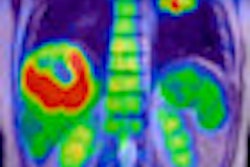CHICAGO - From a radiology perspective, meaningful use guidelines are challenging, with a minefield of unknowns and pitfalls. It's perhaps unsurprising, then, that a panel discussion on how radiology practices are actually handling meaningful use attracted quite a crowd on Tuesday at RSNA 2011.
What do radiologists really know? It's fair to say that most radiologists who treat Medicare or Medicaid patients on an outpatient basis know that by 2015, compliance with stage 1 requirements of the U.S. Department of Health and Human Services' (HHS) initiative to promote electronic medical records will be necessary to avoid financial penalties. They also know that there's a financial incentive: up to $44,000 per physician for those who achieve all goals.
Unfortunately, the meaningful use guidelines weren't developed to meet the needs of radiology or, for that matter, any other medical specialty. So it's no surprise that nearly 40% of radiologists reported in an RSNA-sponsored survey performed by market research firm KLAS that they were concerned about lack of clarity in meaningful use guidelines and/or their impact on their practices' efficiency.
One-fourth of the 208 survey respondents also reported that they were very involved in making decisions regarding meaningful use, yet only 6% said they were well-versed on this subject. RIS vendors have been scrambling for the past year to develop and obtain certification of approval for their products.
Today, about one-third have systems approved that meet all requirements, another third have been approved for a modular product that requires interfacing with other approved "modules," and the remainder are in the 12- to 18-month development process. This was according to a status update from Dr. Keith Dreyer, PhD, who is vice chairman of radiology for informatics at Massachusetts General Hospital and co-chair of the American College of Radiology's (ACR) IT and Informatics Committee.
Case 1: Center for Diagnostic Imaging
So does it pay to play? Steve Fischer, chief information officer of the Center for Diagnostic Imaging (CDI), determined that his Minneapolis-based organization could receive $2.18 million over five years, at a cost of $1.05 million during that time period.
CDI owns and operates 60 diagnostic imaging centers in 10 states. It partners with hospitals, approximately 200 radiologists, and health services to offer outpatient radiology services, but it does not own any radiology practices. It utilizes a single RIS, which interfaces with four or five different PACS.
"It made sense for CDI to achieve meaningful use, but we had to determine who makes the investment and who receives the financial incentives," Fischer said. "We decided that a 50/50 or 75/25 split were the best two options, and ultimately decided that CDI would assume the entire investment, receiving 75% of the stimulus payment after subtracting expenses."
The organization quickly learned the realities of having a complete ambulatory care eligible professional (EP) electronic health record (EHR) solution. The RIS wasn't fully certified, so it was necessary to acquire additional modules. CDI had started its planning process in January 2011 and completed its assessment of the viability of an October 31, 2011, registration by the end of March. However, the company missed the deadline by just days, due to vendor module certification issues and integration-related delays. CDI applied for certification on November 14, 2011. It will start collecting data on January 1, 2012.
CDI needed to develop a reporting dashboard. A dashboard that monitors whether each individual radiologist is on track with respect to achieving the compliance metrics is imperative, Fischer emphasized.
"It's an all or nothing situation," he said. "If you don't meet the percentage requirements in 90 days, you have to start over. Remember, somebody needs to be responsible for monitoring this, no matter how small a radiology practice."
There were very few changes to the radiologists' workflow after this change was made. Front desk staff was the most affected by an increased workload.
CDI also created a patient portal that made it possible for patients to have access to their records. After some referring physicians expressed concern that their patients might access radiology reports before the physicians had a chance to talk with them, reports were delayed for several days before being posted for patient access.
Fischer also encouraged radiologists to actively lobby the U.S. Centers for Medicare and Medicaid Services (CMS) and the Office of the National Coordinator for Health Information Technology (ONC) to incorporate the needs of the radiology profession into the requirements for the two remaining stages still being planned.
"These need to be specialty focused," he said. "We can make a difference."
In a presentation summarizing "the basics" of meaningful use from the perspective of radiologists, Dreyer had made the same point. He discussed how the ACR had been lobbying heavily to engage CMS and ONC in understanding the requirements of radiologists and the importance of imaging. Dreyer said that he and other ACR representatives met with the ONC in October to discuss stage 2 and 3 requirements, and that more meetings are scheduled for December to specifically discuss imaging. He hopes this will produce some positive changes in the stage 2 recommendations that were proposed earlier this year.
Case 2: Advanced Medical Imaging Consultants
Advanced Medical Imaging Consultants (AMIC) is a private practice located in Fort Collins, CO. Its 27 radiologists serve two major competing hospital systems, each with different PACS, dictation, hospital information systems, electronic medical records, and electronic health records. The practice also has its own radiology IT infrastructure that is being utilized by more than 20 sites, including small and medium-sized rural hospitals, clinics, and specialty imaging centers. Some of these use AMIC's PACS exclusively; others use the practice's teleradiology services and images reside on the system in that capacity.
Healthcare IT software at these sites ranges from sophisticated to virtually none at all. Some do not plan to obtain it, according to radiologist Dr. J. Raymond Geis. Compounding the problem is that the practice's largest client, a major health system, recently announced it will replace its existing hospital information system and potentially much of its other healthcare IT software as well.
"This large matrix of software with which we interact, or with which we may potentially interact as needed to qualify, is a moving target," Geis said. "It runs the whole spectrum of HIT certification. It is like early DICOM conformance, a time when a vendor says their software is 'HIT certified,' but that's often only partly true. Understanding these certification gaps is not trivial. We struggle to understand how all our disparate pieces fit together, and if our matrix will fulfill meaningful use requirements."
The practice has a formal group evaluating meaningful use. In addition to Geis, it consists of the chief information officer, the compliance officer, and the in-house attorney. At the moment, the practice is in a "wait and proactively assess mode."
"Three of our health systems started to offer certified outpatient EHRs, from two different vendors," Geis said. "In one sense it solves a huge problem, as we may also 'possess' these EHRs. We will get credit if anyone develops a patient's problem list, takes his or her blood pressure, or records smoking history."
But there are problems with this. The practice has not yet been able to accurately define the total percentage of its patients in these EHRs. The number is dynamic, and the calculation is not straightforward. How do radiologists count patients who are in more than one of these EHRs? These and other questions have no clear answers.
Case 3: Southwest Diagnostic Imaging
Southwest Diagnostic Imaging is located in the Phoenix metropolitan area. Its 69-radiologist practice serves five area hospitals and operates 22 imaging centers. Dr. James Whitfill, chief medical informatics officer, said that the forward-thinking practice first began to look at meaningful use requirements about 18 months ago.
Achieving meaningful use seems to make financial sense, he said. "A $3 million stimulus payment should incentivize us."
The practice worked with its vendor to help the vendor achieve modular certification of its RIS. It invested heavily in a data warehouse and business intelligence systems to be able to create the type of meaningful use dashboard required to monitor progress and demonstrate compliance. It has invested heavily in HL7-based connectivity to more than 100 physician practices in the Phoenix area. The practice also performed preliminary surveys with its radiologists to see if they felt they could attest that certain criteria were or were not relevant to their clinical practice.
However, despite these steps, Southwest Diagnostic is holding off for now. "Our plan remains to monitor the rapidly changing landscape and work toward implementation of our meaningful use program in either 2012 or 2013," Whitfill said.
Why? The practice is in the midst of a merger with two other organizations. This will introduce additional RIS, PACS, and reporting systems into the IT infrastructure. While the practice won't get the full $44,000 per radiologist it would have received if it attained meaningful use qualification in 2012, the financial drop-off rate isn't tremendous, from Whitfill's perspective.
What concerns him is that "the field is changing dramatically every three months," he said. "Targets are changing. Technology is changing." The practice decided to let others dodge the arrows and learn from their experiences.
One issue that Whitfill raised with his chief operating officer related to the ways in which meeting meaningful use requirements would affect imaging exam workflow. As an example, he explained that with a mammography exam scheduled every six minutes at its women's imaging centers, the practice needed to see what impact taking blood pressure and obtaining medication input from patients would have. The operational and opportunity costs of implementation should be fully understood and incorporated as expenses that offset the stimulus payment, Whitfill said.
Case 4: Robert Wood Johnson and Carilion Clinic
Robert Wood Johnson University Hospital in New Brunswick, NJ, and Carilion Clinic in Roanoke, VA, both achieved nirvana: meaningful use! Chief Information Officer Alberto Goldszal, PhD, discussed at length many of the technical issues that the hospital dealt with to get the radiology information system interfaced.
Of the 90-plus radiologists who work at the hospital, 70 have attested and are meeting requirements. The process affected them minimally, Goldszal explained. The burden has been shouldered primarily by the radiology department front desk staff (42%) and by the RIS manager and staff (35%). Hospital IT staff contributed 8% of the initiative, mostly relating to security issues. Radiologic technologists contributed 11%, leaving the radiologist involvement at only 4% of time expended.
Goldszal attributed the success of the initiative to detailed planning, with a core group assigned to handle issues, of which there were many to work through. He strongly recommended that any organization establish a meaningful use policy, a robust and ongoing training program, and a strong compliance monitoring program.
"If radiologists are not achieving their compliance levels, you need to make changes immediately to ensure that this will happen," he said.
He also encouraged attendees to verify that the vendors they are interested in have the ONC-certified products they need, and not to presume anything. And he strongly recommended that an independent security firm be retained to conduct an external security risk assessment.
Dr. David Weiss was fortunate. Carilion Clinic, a large, multispecialty clinic, did all of the work. He just needed to verify that radiologists were included in the program, Weiss said.
And there was another fortunate radiologist in the audience. She volunteered that her practice's RIS vendor was one of the first to become fully EHR-certified. The vendor worked with the practice, and the practice has already received its stimulus payment out of the $1 billion that has already been paid by the federal government.



















